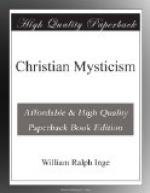23. Herrmann (Verkehr des Christen mit Gott). “The most conspicuous features of the Roman Catholic rule of life are obedience to the laws of cultus and of doctrine on the one side, and Neoplatonic Mysticism on the other.... The essence of Mysticism lies in this: when the influence of God upon the soul is sought and found solely in an inward experience of the individual; when certain excitements of the emotions are taken, with no further question, as evidence that the soul is possessed by God: when at the same time nothing external to the soul is consciously and clearly perceived and firmly grasped; when no thoughts that elevate the spiritual life are aroused by the positive contents of an idea that rules the soul,—then that is the piety of Mysticism.... Mysticism is not that which is common to all religion, but a particular species of religion, namely a piety which feels that which is historical in the positive religion to be burdensome, and so rejects it.”
These extracts from Harnack and Herrmann represent the attitude towards Mysticism of the Ritschlian school in Germany, of which Kaftan is another well-known exponent. They are neo-Kantians, whose religion is an austere moralism, and who seem to regard Christianity as a primitive Puritanism, spoiled by the Greeks, who brought into it their intellectualism and their sacramental mysteries. True Christianity, they say, is faith in the historic Christ. “In the human Jesus,” says Herrmann, “we have met with a fact, the content of which is incomparably richer than that of any feelings which arise within ourselves,—a fact, moreover, which makes us so certain of God that, our reason and conscience being judges, our conviction is only confirmed that we are in communion with Him.” “The mystic’s experience of God is a delusion. If the Christian has learnt how Christ alone has lifted him above all that he had even been before, he cannot believe that another man might reach the same end by simply turning inward upon himself.” “The piety of the mystic is such that at the highest point to which it leads Christ must vanish from the soul along with all else that is external.” This curious view of Christianity quite fails to explain how “our reason and conscience” can detect the “incomparable richness” of a revelation altogether unlike “the feelings which arise within ourselves.” It entirely ignores the Pauline and Johannine doctrine of the mystical union, according to which Christ is not “external” to the redeemed soul, and most assuredly can never “vanish” from it. Instead of the “Lo I am with you alway” of our blessed Lord, we are referred to “history”—that is, primarily, the four Gospels confirmed by “a fifth,” “the united testimony of the first Christian community” (Harnack, Christianity and History). We are presented with a Christianity without knowledge (Gnosis), without discipline, without sacraments, resting partly on a narrative which these very historical critics tear in pieces, each in his




